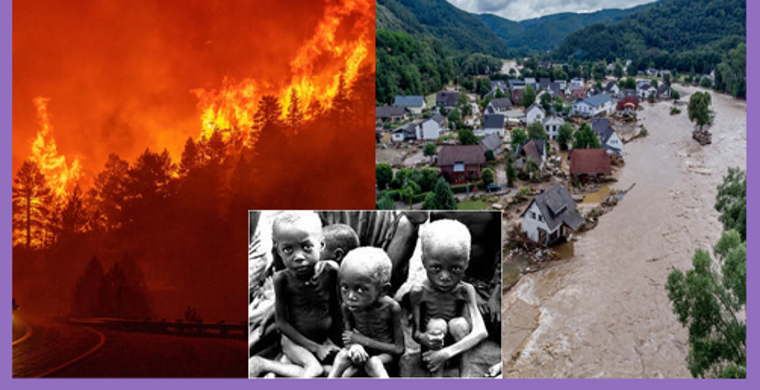Flood, fire, famine and pestilence: the end is nigh (maybe)
Archbishop Cranmer
July 16, 2021
Wildfires blaze across the western states: California and Oregon burn day and night. Death Valley hit a blistering 54.4°C, which might be the highest recorded ambient temperature on Earth. Across Germany and Belgium, floods are devastating states and lives: thousands are homeless, hundreds have died in a deluge of misery. Lapland and Siberia are sweltering; India and Libya are baking. Tokyo is flooding, and so did London this week when a month of rain fell in a single day.
And famine stalks Ethiopia: there is no food in Tigray, and no 'Live Aid' to sing for the starving children. A million are just walking skeletons; five million go hungry every day, while the animals find a hole to lay their heads, curl up and die. And Covid is the cataclysm of the age; the pestilence which has infected 200 million and killed around four million loved ones. The end must be nigh.
Or perhaps not, for we have been here many times before.
The whole thrust of Jesus' preaching would have created an eschatological crisis for his first-century Jewish audience. He gave the distinct impression that the end was imminent; he preached that the Kingdom of Heaven was near or that it had come; that he was fulfilment of Isaiah 61; and he urged disciples to be ready at all times. Like the eager followers of the many other prophets and messianic figures who flit through the pages of first-century Jewish history, Jesus' hearers would have understood their leader to be promising them the final victory for which the nation as a whole was longing. The gospel writers had dealt with some of Jesus' apocalyptic teaching, speaking of the desolation of the Temple and the destruction of Jerusalem, but they linked them thematically for the first time to the coming of the Son of Man.
It was an evocative apocalyptic device. The woes of the destruction of the Temple became a foretaste of the end-time judgement: social chaos, extreme weather events, enemy invasion, the sun and moon darkening, and the great and dreadful day of the Lord appearing.
The Early Church had an expectation that the end, the final consummation, would follow soon. The Resurrection itself was the 'first fruits' fulfilment of an apocalyptic event, and there was constant speculation of the imminent restoration of the kingdom to Israel. Peter's speech at Pentecost, as a fulfilment of the prophecy of Joel, further exacerbated the imminence, as this gift was to be given for the last days. It would have been incomprehensible to the disciples that the last days would go on for more than 20 centuries. There was the constant yearning for Jesus to return and to do so soon.
And yet there was a delay: like waiting for Godot, the parousia never came. This called into question the early belief that the coming of Jesus had inaugurated the last days and that the end of the age was imminent. The neat eschatological chronology of an age of promise followed by an era of fulfilment morphed into the age of promise, the middle of time (Jesus and the Early Church), and the final age, shunting the parousia off into a distant future, leaving the Holy Spirit to fulfil the imminent expectation of the end.
The outpouring of the Holy Spirit marked the beginning of the epoch of the Church, not the beginning of the End. Jewish apocalyptic may not have perceived the End in terms of the destruction of the space-time universe, but the symbolic language was rather an expression of socio-political change within the present world order. In Jesus' ministry the eschaton moved from the future to the present, which little room for any future eschatology, and, indeed, leads some to dismiss a literal Second Coming as a myth.
And to many Christians (including quite a few clergy) the Second Coming is indeed a myth. The floods, fires, famines and pestilences of our age are plagued with false prophets, whose coming was also prophesied. They preach another Christ, lead the faithful astray, conflate cosmic phenomena with political disasters, and turn Israel into the Church. They read end-of-the-world language as the only set of metaphors adequate to express the significance of what will happen, and what will happen has nothing to do with space-time history, but the need to establish the kingdom of God through political action and social intervention: it is all about equality, diversity, and tolerance. They don't so much watch and pray, as judge and bray.
Eschatological thinking is vital to faithful conduct and to hope: there will be an end to life as it now is, an end that comes as both judgment and redemption. Personal theological preferences do not alter eschatology, and contemplation of that fact should have some sanctifying influence. The apocalyptic incorporates both socio-political transformation and cosmic renewal of a kind made possible only by God's supernatural intervention into history, still without bringing about the end of the space-time universe. The floods, fires, famines and pestilences we are witnessing are not the end; they are not the Four Horsemen of the Apocalypse, but they are the groans of nature and the stuff of end-time events. The soon-to-come events need to be seen in connection with God's ultimate intervention in human affairs. We can cavil about the distinction between the working out of God's purposes in our generation and the ultimate working out of God's purposes, but Jesus is not concerned to impart apocalyptic secrets, but to prepare us spiritually for what lies ahead.
END














